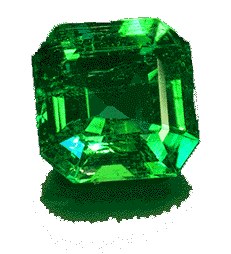

Ocurrance:
Colombia, Brazil, Zimbabwe
(Rhodesia), South Africa, Ural mountains (Russia), Zambia, India, Tanzania,
Pakistan, Australia, U.S. (Connecticut, Maine, North Carolina), Austria
and Norway.
Appearance:
Emerald refers to the
green variety of beryl. There are however, gem quality green beryls which
are not emeralds. All emeralds contain inclusions, which are evidence as
to the genuineness of the stone, but the rare few have visible inclusions
of Mica, Pyrite or Calcite or the "garden" type
inclusions. Inclusions
can be important in separating natural from synthetic Emeralds and for
identifying the country
of origin. The name is derived from the Greek word Smaragdos, meaning "green
stone". The top color for Emerald is a deep Green.
Something
Extra:
Emerald is usually treated
with colorless oil, wax, or natural and synthetic resins into voids to
improve appearance. Surface cavities of emerald is commonly filled with
a hardened colorless Emerald is usually treated with colorless oil, wax,
or natural and synthetic resins into voids to improve appearance. Surface
cavities of emerald is commonly filled with a hardened colorless substance.
Emerald is also occasionally dyed with dye or colored oi.
The vibrant Green of Emerald
has long stood for fertility and rebirth. Many cultures have used Emerald
as a treatment for eye diseases, epilepsy and poisoning. Emeralds have
been held under the
tongue as a way of foretelling
the future. They were dedicated to the goddess Venus and were
considered an aid in
revealing the truthfulness of one's lover. But their incomparable beauty
is reasonenough for owning this Gem.
Cleopatra prized her emeralds
more than any other gem. She may have dropped her pearls in her
wine for Mark Anthony
but she kept her emeralds for herself! The ancient emerald mines of
Cleopatra, long a mystery,
were discovered again a hundred years ago near the Red Sea. Some
tools found in the mine
were dated at 1650 B.C. but no quality emeralds were found: the mines were
exhausted thousands of years ago. Mummies in ancient Egypt were often buried
with an emerald on their necks carved with the symbol for verdure, flourishing
greenness, to symbolize eternal youth.
The Romans also loved
emeralds because, as ancient scholar Pliny said, "nothing greens greener."
Pliny said that emerald
was the only gem which delighted the eye without fatiguing it. He said
his eyes were restored when gazing at emerald. Emperor Nero wore emerald
sunglasses to watch the
gladiators.
One legend says that Satan
lost the emerald from his crown when he fell. The emerald was shaped
into a bowl which the
Queen of Sheba sent to Nicodemus. Christ used the bowl at the last supper
and Joseph of Arimathea
used the bowl to catch blood from the cross, founding the order of the
Holy Grail.